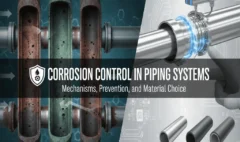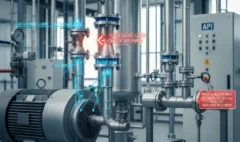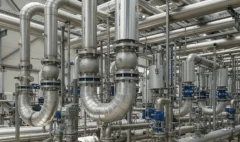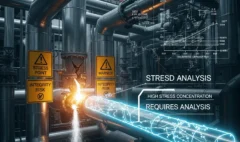Carbon Steel vs. Stainless Steel vs. Alloy Steels: Selecting the Right Pipe Material 🛠️🧪
0 comments
Carbon Steel vs. Stainless Steel vs. Alloy Steels: Selecting the Right Pipe Material 🛠️🧪
- Introduction: Material selection as a cornerstone of piping design. Balancing performance, cost, and safety. Overview of the main metallic piping material families.
- Carbon Steels: The workhorse of the industry.
- Composition: Primarily iron and carbon (typically < 2.1% C), with small amounts of manganese and other elements.
- Common Grades (ASTM/ASME):
- ASTM A106/ASME SA-106 (Seamless): Grades B, C. For high-temperature service.
- ASTM A53/ASME SA-53 (Seamless & Welded): Grades A, B. General purpose pipe.
- API 5L (Seamless & Welded): Grades B, X42, X52, X60, X65, X70, etc. For line pipe.
- ASTM A234/ASME SA-234 WPB, WPC (Fittings).
- ASTM A105/ASME SA-105 (Forgings - Flanges).
- Properties: Good strength, ductility, weldability, relatively low cost.
- Advantages: Economical, readily available, well-understood behavior.
- Limitations: Prone to corrosion (rusting) in many environments, limited high-temperature strength (creep becomes an issue above ~427°C/800°F), susceptible to brittle fracture at low temperatures (unless specifically manufactured for low-temp service, e.g., A333).
- Typical Applications: Water, steam, oil, gas (non-corrosive or with inhibitors), structural supports.
- ASME B31.3 Considerations: Widely used, with allowable stresses listed in Appendix A. Carbon equivalent for weldability.
- Stainless Steels: For corrosion resistance and/or high/low-temperature service.
- Composition: Iron-based alloys containing at least 10.5% Chromium, which forms a passive protective layer. Nickel, Molybdenum, and other elements are added to enhance properties.
- Main Types & Common Grades (ASTM/ASME):
- Austenitic (e.g., TP304/304L, TP316/316L, TP321, TP347 - from A312/SA-312): Most common, good corrosion resistance, excellent ductility and formability, good high-temp strength and low-temp toughness. Non-magnetic. 'L' grades (low carbon) for better weldability and resistance to sensitization.
- Ferritic (e.g., TP405, TP430): Good corrosion resistance (especially to chloride SCC), magnetic. Less ductile than austenitics.
- Martensitic (e.g., TP410): Can be hardened by heat treatment, high strength, moderate corrosion resistance. Magnetic.
- Duplex (e.g., 2205, 2507): Mixed austenitic-ferritic microstructure. High strength, excellent resistance to chloride SCC and pitting.
- Advantages: Excellent corrosion resistance in specific environments, good appearance, hygienic.
- Limitations: Higher cost than carbon steel, can be susceptible to specific corrosion forms (e.g., chloride stress corrosion cracking for austenitics).
- Typical Applications: Chemical processing, food & beverage, pharmaceuticals, marine environments, cryogenic service (austenitics), high-temperature service.
- ASME B31.3 Considerations: Extensive use, specific rules for different types, allowable stresses in Appendix A. Welding considerations can be more complex.
- Alloy Steels: Enhanced properties for demanding conditions.
- Composition: Steels alloyed with elements other than carbon (e.g., Cr, Mo, Ni, V, W) to improve strength, toughness, creep resistance, corrosion resistance, or hardenability.
- Low Alloy Steels (e.g., Chrome-Moly Steels):
- Grades (ASTM A335/ASME SA-335 for pipe): P1, P5, P9, P11, P22, P91, P92. These have varying Cr and Mo contents.
- Properties: Improved high-temperature strength (creep resistance) and sometimes better corrosion/oxidation resistance than carbon steel.
- Applications: Power plants (steam lines), refineries (high-temp process lines). P91/P92 are advanced creep strength enhanced ferritic (CSEF) steels requiring very careful fabrication and heat treatment control.
- High Alloy Steels: (Stainless steels are a subset). Others include nickel-based alloys (often not called 'steel').
- ASME B31.3 Considerations: Critical for high-temperature design. Specific preheat and Post-Weld Heat Treatment (PWHT) requirements in ASME B31.3 Chapter V are vital, especially for Cr-Mo and CSEF steels. Allowable stresses in Appendix A.
- Factors Influencing Material Selection (Reiteration): Fluid handled, pressure, temperature (min/max), corrosion concerns, mechanical strength, toughness, cost, availability, weldability.
- Conclusion & Call to Action: Choosing the right piping material is a complex decision with significant safety and economic implications. A deep understanding of material properties, advantages, limitations, and relevant ASME B31.3 (Chapter III on Materials, and Appendix A) requirements is essential. In-depth courses on metallurgy, corrosion, and material selection specifically for piping applications empower engineers to make informed choices that ensure long-term system integrity.
Related Posts
Search
Categories
Popular Tags
3D CAD
API
ASME
ASME B31.3
ASME B31; Mechanical Completion
ASME Codes and Standards
B31.3 Information
Carbon Steel
Chemical Engineering
ISA
Material Selection
Mechanical Engineering
Oil And Gas
Pipe Stress Analysis
Piping
Piping Codes
Piping Designer
Piping Design Software
Piping Engineer
Piping Engineering
Piping Materials
Piping Stress Analysis Engineering
Project Management
Project Scope
Safety in Piping Systems
SmartPlant 3D
Stainless Steel
Stress Analysis
Training; ASME Courses
Valve Selection
| S | M | T | W | T | F | S |
|---|---|---|---|---|---|---|
| 1 | ||||||
| 2 | 3 | 4 | 5 | 6 | 7 | 8 |
| 9 | 10 | 11 | 12 | 13 | 14 | 15 |
| 16 | 17 | 18 | 19 | 20 | 21 | 22 |
| 23 | 24 | 25 | 26 | 27 | 28 | 29 |
| 30 | ||||||









